
A federal jury has ordered a group of white supremacists to pay over $26 million in damages for their role in organizing the deadly 2017 “Unite the Right” rally in Charlottesville, Virginia. “Is bankrupting these organizations, is bankrupting these individuals enough to actually stop the growing threat … of white supremacy and Nazism in the United States?” asks Slate senior editor Nicole Lewis. “I don’t think so.” Lewis also discusses the Ahmaud Arbery murder case and why claims of self-defense from armed white people serve as a “racist dog whistle.” She says it’s inevitably a one-sided trial when “the McMichaels are the only ones [surviving] that get to claim they’re scared.”
Transcript
AMY GOODMAN: A federal jury in Virginia has ordered a group of white supremacists to pay over $26 million in damages for their role in organizing the deadly 2017 “Unite the Right” rally in Charlottesville. The jury found the organizers guilty of violating a Virginia state conspiracy law, but jurors deadlocked on two federal conspiracy charges, including violating the 1871 Ku Klux Klan Act.
In August 2017, several hundred white supremacists marched with tiki torches across the University of Virginia, chanting “You will not replace us,” “Jews will not replace us,” and “White lives matter.” The next day, self-described neo-Nazi James Alex Fields slammed his car into a crowd of antiracist counterprotesters, killing Heather Heyer and injuring dozens of others.
On Tuesday, Fields, who is already serving a life sentence, was ordered to pay $12 million in punitive damages. Prominent white supremacists Richard Spencer, Jason Kessler and Christopher Cantwell and eight other defendants were also ordered to each pay over half a million dollars in punitive damages. While it’s unclear how much money the men will actually pay, many observers are crediting the civil lawsuit with helping to bankrupt numerous far-right institutions.
We’re joined now by Nicole Lewis, senior editor of jurisprudence at Slate.
Nicole, welcome to Democracy Now! In a moment we’re also going to go to Georgia with you to talk about the Ahmaud Arbery murder trial, but right now talk about the significance of this civil suit, of the jury finding these men guilty and what $26 million means.
NICOLE LEWIS: Sure. So, the lawyers for the plaintiffs said that this judgment, this amount of money, really sends a message to other people who might think that they want to show up and commit violent acts in cities, that they can’t get away with it, that there won’t be — that they won’t get off scot-free, that there will be some repercussions. And so, $26 million, it’s a lot of money, but there’s a big question about: Will these defendants be able to pay it? You know, Chris Cantwell, James Fields are already incarcerated, and so they’re not earning a ton of money. Many of the other defendants are already destitute from all of the pre-investigation leading into this trial, the fact that they are not able to work, that they’re now publicly known as white supremacists and neo-Nazis, who are, you know, unemployable in a lot of industries and institutions, right?
And so, I think there is just this big outstanding question of: How much money will they actually be able to come up with? And what strategies do they have to be able to extract money from these folks? You know, liens on houses, garnishing wages, things like that. But I think the bigger picture here is that they came into Charlottesville with the intention to create and start a race war and that the criminal justice system hasn’t found any liability, but in a civil system we say, “You cannot get away with this.”
JUAN GONZÁLEZ: And in terms of the organizations that these men belong to, many of them are either going to declare bankruptcy and then reorganize under other names, or — what’s your sense of what’s happened to the organizations?
NICOLE LEWIS: Yeah. So, that’s an excellent question, and I think it’s the question that we’re all grappling with or dealing with, to say: Is bankrupting these organizations, is bankrupting these individuals enough to actually stop the growing threat, the rising threat of white supremacy and Nazism in the United States? We know that there are a number of young men who feel disaffected and displaced, and they’re gathering every day in chatrooms to share ideas, to commiserate, to strategize. And so there’s a high likelihood that the organizations that exist now become defunct, they turn over whatever assets they might have on hand, and then new organizations are started, and new people come together in chatrooms to plan for this kind of thing. And so I think it’s just the open question of we don’t yet know.
And I think it’s important to point out that this was the strategy used to try to take down the Ku Klux Klan in the Jim Crow era and through the civil rights movement, right? And so there was some effectiveness there. But again, looking back in time and sort of moving forward, we see that one hateful group, one white supremacist group, just morphed into new factions and new iterations of the same ideology. And so, is bankrupting them actually truly enough to stamp out hate? I don’t think so. I think there are many people who study hate and extremism who know just how extraordinary the threat is and that financial damages just simply won’t be enough to do that.
JUAN GONZÁLEZ: In October, you co-wrote a piece with Dahlia Lithwick titled “Three Trials in America: The conversations playing out in courtrooms in Kenosha, Charlottesville, and Georgia are revealing. What do you find revealing about and the connections between all three of these?
NICOLE LEWIS: Absolutely. So, I think, you know, every few years we get a series of cases that people look to, to say, “Will the ruling, will the outcome here, finally be an indication that we have made progress in terms of race and racial relations and racial justice?” And so, the case in Kenosha, the case in Georgia, the Charlottesville case, I really don’t think you could get three sort of bigger, more significant cases: one, Charlottesville, about the rise of extremism, Nazism, our First Amendment rights — like, what right do you have actually to create violence in public spaces? — the trial in Kenosha about whether or not we have — you know, whether or not the Second Amendment, our gun rights, are sort of more important than our ability to peacefully assemble — right? — and then we have the case in Georgia, that really reflects this long legacy of racial violence in the South. The three defendants are white. Ahmaud Arbery, the young unarmed jogger, was Black. Right? And so they just encapsulate all these different components, all these different issues happening in our country right now.
And what Dahlia and I were trying to point out is that the criminal justice system, even the civil system — right? — the Charlottesville case is not a criminal case — is simply just ill-equipped to deal with these extraordinary questions of race. It is the same system that disproportionately sends Black and Latino men to prison at extraordinary rates. And so, when we bring white defendants into the system and ask it to litigate and to say, “Let’s find justice here,” many of us watching know that it won’t be able to do that. And I think the Rittenhouse trial, for many — the Rittenhouse verdict, excuse me, for many, was devastating for that reason. People did not expect that he would be treated the way that he was, that he would be acquitted, right?
And so, there’s another component here. When Dahlia and I watched the jury selection in many of these cases, we could not help but notice just how much prosecutors — excuse me, the defense attorneys, in particular, treated racism like an open question. And so, any juror who believed that racism is real, that Black Lives Matter is not a terrorist organization, that in fact it emerged in response to state-sanctioned violence against Black people, anyone who believed those things to be true was struck from the jury, that it was read as somehow not being neutral and not being objective, of not having an open mind, when we know that these are settled and established facts. And so I think we just saw the extraordinary limitation here to say, “Well, what can we do if the jury pool is now comprised of people whose minds are not made up about Nazism, whose minds are not made up about the horrors, the violence and the evil of white supremacy?” And so, that’s just another extraordinary limitation and something that we saw, a thread throughout all three trials.


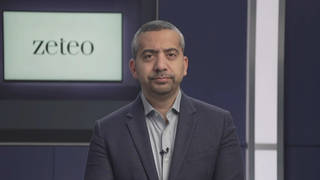
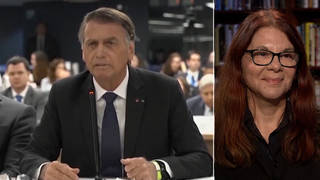
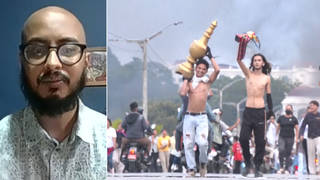
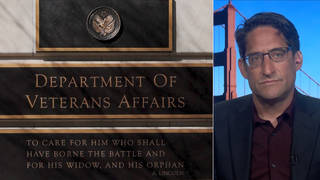
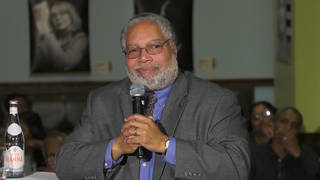



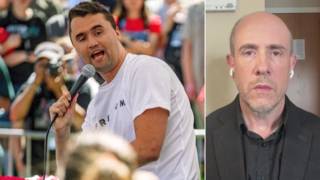
Media Options